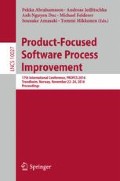Abstract
Context: Previous research investigated how to approach architecting in agile projects (e.g., in terms of processes and practices), but the role that architects play in Scrum is still not well understood. Objective: We aim at capturing scenarios of how architects (or those taking on architecture-related tasks) are involved in Scrum. Furthermore, we aim at identifying how those taking on the role of the architect interact with other roles in Scrum. Method: We conducted a multiple case study and interviews with practitioners from six Dutch software organizations. Results: We identified three generic scenarios of architects in Scrum (“internal architect”, “external architect”, “internal and external architects”). We found that how architects interact with other roles in Scrum heavily depends on the Product Owner role. Conclusions: Some of our results are not in line with recommended practices in the Scrum Guide. Our findings support those who take on architecture-related tasks in preparing for Scrum-like projects.
Access this chapter
Tax calculation will be finalised at checkout
Purchases are for personal use only
Notes
- 1.
- 2.
- 3.
- 4.
- 5.
- 6.
- 7.
- 8.
- 9.
- 10.
- 11.
References
Bass, L., Clements, P., Kazman, R.: Software Architecture in Practice. Addison-Wesley, Boston (2012)
Abrahamsson, P., Babar, M.A., Kruchten, P.: Agility and architecture: can they coexist? IEEE Softw. 27, 16–22 (2010)
Yang, C., Liang, P., Avgeriou, P.: A systematic mapping study on the combination of software architecture and agile development. J. Syst. Softw. 111, 157–184 (2016)
Eloranta, V.-P., Koskimies, K.: Lightweight architecture knowledge management for agile software development. In: Babar, M.A., Brown, A., Mistrik, I. (eds.) Agile Software Architecture. Morgan Kaufmann, Boston (2014)
VersionOne Inc.: 9th Annual State of Agile Survey (2015)
Runeson, P., Hoest, M.: Guidelines for conducting and reporting case study research in software engineering. Empirical Softw. Eng. 14, 131–164 (2009)
Schwaber, K.: Agile Project Management with Scrum (Developer Best Practices). Microsoft Press (2004)
Schwaber, K., Beedle, M.: Agile Software Development with Scrum. Prentice Hall, Upper Saddle River (2002)
Friedrichsen, U.: Opportunities, threats, and limitations of emergent architecture. In: Babar, M.A., Brown, A., Mistrik, I. (eds.) Agile Software Architecture, pp. 335–355. Morgan Kaufmann, Boston (2014)
Diebold, P., Ostberg, J.-P., Wagner, S., Zendler, U.: What do practitioners vary in using scrum? In: Lassenius, C., Dingsøyr, T., Paasivaara, M. (eds.) XP 2015. LNBIP, vol. 212, pp. 40–51. Springer, Heidelberg (2015). doi:10.1007/978-3-319-18612-2_4
Kruchten, P.: What do software architects really do? J. Syst. Softw. 81, 2413–2416 (2008)
Brown, S.: Software Architecture for Developers. Leanpub (2012)
Faber, R.: Architects as service providers. IEEE Softw. 27, 33–40 (2010)
Angelov, S., Meesters, M., Galster, M.: Architects in scrum: what challenges do they face? In: 10th European Conference on Software Architecture (ECSA), Copenhagen, Denmark. Springer, Switzerland (2016, in press)
Wohlin, C., Runeson, P., Hoest, M., Ohlsson, M., Regnell, B., Wesslen, A.: Experimentation in Software Engineering. Kluwer Academic Publications, Boston (2000)
Kitchenham, B., Pfleeger, S.L.: Principles of survey research - Part 5: populations and samples. ACM SIGSOFT Softw. Eng. Notes 27, 17–20 (2002)
Fowler, M.: Who needs an architect? IEEE Softw. 20, 2–4 (2003)
Miles, M.B., Huberman, A.M.: Qualitative Data Analysis. Sage Publications, Thousand Oaks (1994)
Krippendorff, K.: Content Analysis: An Introduction to Its Methodology. Sage Publications, Thousand Oaks (2003)
Torchiano, M., Ricca, F.: Six reasons for rejecting an industrial survey paper. In: First International Workshop on Conducting Empirical Studies in Industry (CESI), pp. 1–6. IEEE Computer Society, San Francisco (2013)
Babar, M.A., Ihme, T., Pikkarainen, M.: An industrial case of exploiting product line architectures in agile software development. In: 13th International Software Product Line Conference, pp. 171–179. CMU, San Francisco (2009)
Rost, D., Weitzel, B., Naab, M., Lenhart, T., Schmitt, H.: Distilling best practices for agile development from architecture methodology. In: Weyns, D., Mirandola, R., Crnkovic, I. (eds.) ECSA 2015. LNCS, vol. 9278, pp. 259–267. Springer, Heidelberg (2015). doi:10.1007/978-3-319-23727-5_21
Cohn, M.: Succeeding with Agile: Software Development Using Scrum. Addison-Wesley, Reading (2009)
Beck, K.: Extreme Programming Explained. Addison-Wesley, Boston (1999)
Waterman, M., Noble, J., Allan, G.: How much up-front? a grounded theory on agile architecture. In: 37th International Conference on Software Architecture, pp. 347–357. IEEE Computer Society, Florence (2015)
Martini, A., Bosch, J.: A multiple case study of continuous architecting in large agile companies: current gaps and the caffea framework. In: 13th Working IEEE/IFIP Conference on Software Architecture (WICSA), pp. 1–10. IEEE, Florence (2016)
van der Ven, J.S., Bosch, J.: Architecture decisions: who, how and when? In: Babar, M.A., Brown, A., Mistrik, I. (eds.) Agile Software Architecture, pp. 113–136. Morgan Kaufmann, Boston (2014)
Madison, J.: Agile architecture interactions. IEEE Softw. 27, 41–48 (2010)
Martini, A., Pareto, L., Bosch, J.: Role of architects in agile organizations. In: Bosch, J. (ed.) Continuous Software Engineering, pp. 39–50. Springer, Berlin (2014)
Babar, M.A.: An exploratory study of architectural practices and challenges in using agile software development approaches. In: Joint Working IEEE/IFIP Conference on Software Architecture & European Conference on Software Architecture (WICSA/ECSA), pp. 81–90. IEEE Computer Society, Cambridge (2009)
Woods, E.: Aligning architecture work with agile teams. IEEE Softw. 32, 24–26 (2015)
Author information
Authors and Affiliations
Corresponding author
Editor information
Editors and Affiliations
Rights and permissions
Copyright information
© 2016 Springer International Publishing AG
About this paper
Cite this paper
Galster, M., Angelov, S., Meesters, M., Diebold, P. (2016). A Multiple Case Study on the Architect’s Role in Scrum. In: Abrahamsson, P., Jedlitschka, A., Nguyen Duc, A., Felderer, M., Amasaki, S., Mikkonen, T. (eds) Product-Focused Software Process Improvement. PROFES 2016. Lecture Notes in Computer Science(), vol 10027. Springer, Cham. https://doi.org/10.1007/978-3-319-49094-6_29
Download citation
DOI: https://doi.org/10.1007/978-3-319-49094-6_29
Published:
Publisher Name: Springer, Cham
Print ISBN: 978-3-319-49093-9
Online ISBN: 978-3-319-49094-6
eBook Packages: Computer ScienceComputer Science (R0)

